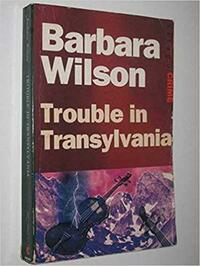Take a photo of a barcode or cover
This is less a mystery than a travelogue, although a very interesting one, peppered with feminist politics, history, and economics and salted with a mystery that blends all of these things together. It’s not a great book, but it is fairly delightful.
Cassandra Reilly is a world traveler who decides to spend some time with her friend Jack in Hungary. Somehow, she gets roped into helping some travelers who get embroiled in a suspicious death in the nearby Romanian province of Transylvania. Said travelers are as entertaining a bunch as you are likely to find. An elderly woman taking a cure at a health spa, her 19-year-old lesbian granddaughter (who takes a shine first to Cassandra, then to her friend Jack) and a family named Snapp who are searching for the birth mother of a four-year-old girl they adopted as a baby.
But although all the characters are interesting (which is very rare in itself) and the mystery mildly interesting, it is the author’s care in describing the history of the area that gives the book its punch. Without dwelling overlong on the Dracula theme, it gives the history of Romania and Hungary from both perspectives. And Transylvania has ties to both, it being part of Romania but with a mostly Hungarian population. In addition, Jack has studied the goddesses of Old Europe and is a fountain of information on this prehistorical theme that owes much to the work of Marija Gimbutas.
All in all, the characters (except for the murdered one, of course) have a good time and so does the reader. Well written and well researched without being outstanding, give this one just above an average number of stars.
Note: This review is included in my book The Art of the Lesbian Mystery Novel, along with information on over 930 other lesbian mysteries by over 310 authors.
Cassandra Reilly is a world traveler who decides to spend some time with her friend Jack in Hungary. Somehow, she gets roped into helping some travelers who get embroiled in a suspicious death in the nearby Romanian province of Transylvania. Said travelers are as entertaining a bunch as you are likely to find. An elderly woman taking a cure at a health spa, her 19-year-old lesbian granddaughter (who takes a shine first to Cassandra, then to her friend Jack) and a family named Snapp who are searching for the birth mother of a four-year-old girl they adopted as a baby.
But although all the characters are interesting (which is very rare in itself) and the mystery mildly interesting, it is the author’s care in describing the history of the area that gives the book its punch. Without dwelling overlong on the Dracula theme, it gives the history of Romania and Hungary from both perspectives. And Transylvania has ties to both, it being part of Romania but with a mostly Hungarian population. In addition, Jack has studied the goddesses of Old Europe and is a fountain of information on this prehistorical theme that owes much to the work of Marija Gimbutas.
All in all, the characters (except for the murdered one, of course) have a good time and so does the reader. Well written and well researched without being outstanding, give this one just above an average number of stars.
Note: This review is included in my book The Art of the Lesbian Mystery Novel, along with information on over 930 other lesbian mysteries by over 310 authors.
funny
lighthearted
mysterious
slow-paced
Plot or Character Driven:
A mix
Strong character development:
No
Loveable characters:
Complicated
Diverse cast of characters:
Yes
Flaws of characters a main focus:
No
This book is good at many things: a travel diary through Vienna and Romania, a discussion of the history of Eastern Europe and the tensions between ethnic groups in the post-Soviet era, an incisive look at reproductive rights and the lack of them under the Ceaucescu regime, even a bit of a lesbian romance novel. I liked the older characters the best, but young Cathy Snapp won my sympathy, and it would be interesting to get to know Emma Snapp when she's older.
What it is not good at is the murder mystery itself. It feels like a McGuffin to get out heroine, her buddy, and the buddy's business partner to the Arcata spa. Once they are there, it only crops up every now and then, as if the author were clapping her hand to her forehead and saying, "Oh yes, there's supposed to be some investigation going on!" And I, who never solve mysteries, thought the whodunnit painfully obvious (although the how depended on a bit of science I didn't see coming).
I mainly brought this book home from the Little Free Library because of the blurb by [a:Ursula K. Le Guin|874602|Ursula K. Le Guin|https://images.gr-assets.com/authors/1244291425p2/874602.jpg], but I think she was generous because there were so few lesbian mysteries when it was published.
What it is not good at is the murder mystery itself. It feels like a McGuffin to get out heroine, her buddy, and the buddy's business partner to the Arcata spa. Once they are there, it only crops up every now and then, as if the author were clapping her hand to her forehead and saying, "Oh yes, there's supposed to be some investigation going on!" And I, who never solve mysteries, thought the whodunnit painfully obvious (although the how depended on a bit of science I didn't see coming).
I mainly brought this book home from the Little Free Library because of the blurb by [a:Ursula K. Le Guin|874602|Ursula K. Le Guin|https://images.gr-assets.com/authors/1244291425p2/874602.jpg], but I think she was generous because there were so few lesbian mysteries when it was published.
At times it felt like we were getting a little too much exposition and/or travelogue, but overall this was just as delightful as the first book, and a fascinating look at Transylvania in the 90s.

